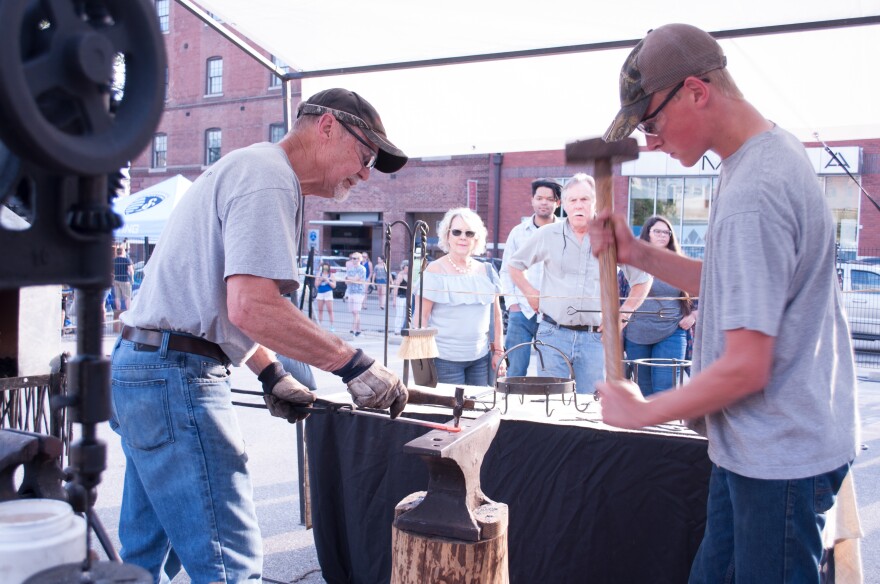Mike McLaughlin has a slightly unusual grievance: He has more blacksmithing equipment than he can actually use. His backyard smithy is 16-by-24 feet and includes two kinds of forge, three anvils and a bunch of hammers and other tools.
But to practice this ancient skill, he notes, "all you really need is a hunk of dirt and a little cover."
The Lawson, Missouri, machinist is part of a growing group of people interested in learning to blacksmith. He’s one 600 members of the Blacksmiths Association of Missouri, or BAM, and began learning 12 years ago.
McLaughlin doesn't consider his creations art — he just makes what he likes. For him, the most important thing is that his finished products be functional, like a coat hook or a little bowl for keys.
Other people, however, tell him he's making art. Specifically, folk art.
The Missouri Folk Arts Program at the Museum of Art and Archaeology at the University of Missouri in Columbia, designates blacksmithing as an "occupational tradition." The program's director, Lisa Higgins, also works with dancers, singers, storytellers, quilters, and others who practice a traditional art.
"If you think about gospel music, for instance, almost all of the gospel artists we have ever worked with, they all started in some kind of sunshine chorus in their church, and typically maybe took piano lessons from the church pianist, and so they would sing together and practice together, but it was all something that… It tied their community together," Higgins says.
She says the skill must be community-based: one person in any sort of community passing the know-how to another in the same community. Blacksmiths statewide are tied together in just that way, a master craftsman teaching a newcomer, a mid-level smith swapping tips with another.
BAM President Steve McCarthy says his organization has grown steadily over the years, with a slight uptick in younger members since the History Channel show "Forged in Fire" began.
Because the regular meetings change locations, very few people are able to attend each one. All the same, when they see each other at their four-day conference in Sedalia the first week of May each year, it still feels like a big family reunion.
"We are a pretty tight-knit community," McCarthy says. "We rely on each other, we visit outside of the organization, we go to each others’ shops and work and play."

At a summer First Friday demonstration hosted by the Mid-America Arts Alliance in the Crossroads neighborhood of Kansas City, three smiths, including McLaughlin, showed onlookers how it was done by making one of his original rain gauge holders. When he first forged the posts and loops that hold the small glass vials meant for collecting rain, he used a jig he built for the scrollwork.
Eventually, it bothered him that each one was the same. In his professional work as a machinist, he turns out many identical items. He went back to "eyeballing" each rain gauge holder and is happier with them.
"And I was welding them together, too, and this one I'm going to rivet together," McLaughlin said of the one he was creating at First Friday. "So, it’ll all be done in a propane forge, and there’ll be no welding, and you know, electric welders or anything."
McLaughlin says he might enroll in one of the Missouri Folk Arts Program's traditional arts apprenticeships (funded by the Missouri Arts Council and the National Endowment for the Arts). At 35 years old, the program is one of the oldest in the nation and has funded more apprenticeships than any other state’s, according to Higgins.
She says her organization is thinking in terms of sustainability.
"It's a partnership with the artist," Higgins explains. "We're not trying to tell them what to do, we're asking them what we can do to help them sustain these traditions, which change, are dynamic; they have innovations."
And during demonstrations at the Renaissance Festival, Makers' Faire, Shoal Creek Living History Museum and the state fair, the smiths can show their innovations and gather more potential blacksmiths into the fold.
McLaughlin seconds that intention: "I think that’s the whole deal. We're still out there, I guess you could say."
Follow KCUR contributor Anne Kniggendorf on Twitter, @AnneKniggendorf.
Correction: An earlier version of this story used the word "farrier" as a synonym for "blacksmith." While all farriers are blacksmiths, not all blacksmiths are farriers.



